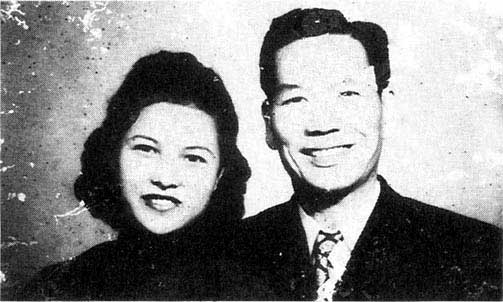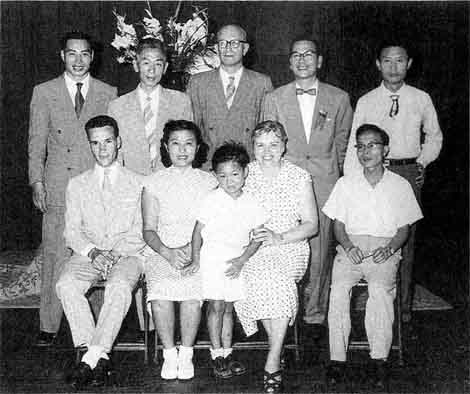
|
Macau Bahá'í Community in the Early Years
by Barbara R. Sims
 |
chapter 4 | start page | single page | chapter 6 |  |
Chapter 5
Mr. Harry Yim
Harry Yim was the first person in Macau to declare his belief in Bahá'u'lláh.
He wrote his name as Yim Pui Foung although the name on his I.D. card was spelled Yim Pu Foung. He also had an identity card for Hong Kong. He was born in 1915 and was originally from Canton, China. His family was prosperous exporting jade, antiques and embroidery.
His wife was killed in China two years after their marriage, during World War II. They did not have children. He did not give details of this situation but told the compiler that that was why he was so lonely through the years. His father's export business was finished during the war and Harry went to Macau taking his younger sisters. He had different jobs; teaching English, buying and selling. After the war he went back to Canton to try to establish a business but with no success. He returned to Macau and started an antique and curio shop.
He learned of the Faith from the Scherers in 1954. Loretta Scherer came into his shop one day looking for a wooden statue. Harry studied with the Scherers for a few months and became a Bahá'í; the first person in Macau to enroll as a member of the Bahá'í Faith. After that, he said he felt that nothing was as important as the Faith. He considered that his spiritual birthday was July 15, 1954, which was the day he decided to declare his belief in Bahá'u'lláh, although the date on his card as countersigned (approved) by the Asia Teaching Committee was September 30, 1954.
Through the years Mr. Yim, along with Mr. John Chang, kept the affairs of the Faith going. Both could speak and write fluent English and made many reports to the mother assembly (after 1957), the National Spiritual Assembly of North East Asia. Mr. Yim came to Japan twice, once to attend the first teaching conference in North East Asia, at Nikko Japan in 1955. The second time was as a delegate from Macau to the third Annual Convention of the Bahá'ís of North East Asia, April 1959, in Tokyo. In the early days, the five pioneers, the Scherers, Mrs. Heller and the Azizis all traveled, but Mr. Yim was the only Chinese Bahá'í from Macau to come to Japan. One of the Japanese Bahá'ís tried to find a Japanese bride for Harry but that idea
did not succeed. Personally Harry was a nice looking man, with a winning smile, and deeply interested in the progress of the Faith of Bahá'u'lláh.
Harry's mother became a Bahá'í in December 1959 during the visit of Hand of the Cause Mr. Ala'i but her enrollment card was approved a month or so later. She was elected to the Local Spiritual Assembly of the Bahá'ís of Macau in 1960.
In the fall of 1960 his mother died but Harry was consoled because she had declared as a Bahá'í the year before. When she was terminally ill he wrote a touching letter to the secretary of the National Spiritual Assembly of North East Asia asking about the Bahá'í method of burial, and we can recall that he asked if it was permissible to use joss sticks. He was very sad, but wanted to do things properly. After her death he wrote to the National Spiritual Assembly of North East Asia,
"My mother had six children and her age was 75. She gained everything in this material world and now she has an open door to a new and greater life!"

Mr. Harry Yim, as a very young man, is shown here with his wife. They had been married just two years when she was killed in China during World War II. He said that was why he had been lonesome through the years.

click for larger image
Nikko, Japan, 1955
This teaching conference, which was sponsored by the National Spiritual Assembly of the United States, was approved by the Guardian of the Faith. Hand of the Cause Mr. Khadem was his representative. The Local Spiritual Assembly of Tokyo made all arrangements as there was yet no National Spiritual Assembly in the North Pacific.
It was the same year that the Guardian announced that a National Spiritual Assembly was to be elected in Tokyo in 1957. It was to be a regional assembly whose area would consist of Japan, Korea, Taiwan, Hong Kong and Macau. The islands of Hainan, off the coast of China, and Sakhalin, north of Japan, were in the original jurisdiction assigned by the Guardian. Both of those areas were closed to pioneers at the time. Hainan was later assigned elsewhere and Sakhalin remained a goal of the National Spiritual Assembly of Japan.
The "Nikko Conference" as it came to be known, was important because all the areas mentioned, except for the last two islands, would need to send delegates to the first National Convention of the Bahá'ís of North East Asia, to be held in Tokyo. Therefore representatives from Korea, Taiwan, Hong Kong and Macau were especially invited to the Nikko Conference.
From Hong Kong came Mr. and Mrs. Seto, and Mr. and Mrs. Azizi. Mr. and Mrs. Scherer came from Macau, and the friends in Japan were delighted when there was a Chinese representative from Macau, Mr. Harry Yim.
Mr. Yim can be seen at the top center between Mr. and Mrs. Scherer at the left, and Dr. and Mrs. David Earl at the right.
Beloved Saichiro Fujita, known to all the Bahá'í world, is holding the frame containing the "Greatest Name". It was he, the second Japanese Bahá'í in the world, who faithfully served 'Abdu'l-Bahá, then the Guardian, and when he passed away Mr. Fujita continued to serve the Hands of the Cause and the Universal House of Justice. Mr. Fujita left soon after the conference to return permanently to serve at the Holy Land.
Hand of the Cause Mr. Khadem is directly behind Mr. Fujita. Miss Alexander is holding a picture of `Abdu'l-Bahá. Mr. Seto is fourth from the top right. Mr. and Mrs. Suleimani (she with the white dress), pioneers to Taiwan, can be seen near the middle to the left.
Mr. John Chang
Mr. Chang was Dean of Students and an English teacher at the Leng Nam Middle School when he became a Bahá'í. In 1961 he became Headmaster of the English Department. It was a Christian school but non-denominational. Between 1958 and 1960 Mr. Chang gave two lectures on the Bahá'í Faith at the Chapel. Some of his students came to meetings. Other early Bahá'ís were also school teachers; Mr. Kao and Mr. Chow, and Mr. Yip.

click for larger image
May 22, 1955. With the declaration of Mr. John Chang the group reached nine. However, at that time it was only possible to form local spiritual assemblies at Ridván. That meant the group had to wait until the next year to accomplish that goal. The next year and the following year it was not possible either because of people leaving. Finally in 1958 they were able to accomplish the goal they had been striving for.
Seated: Mr. Ferreira, Mrs. Mary Shia, Louie Shia, Mrs. Scherer and Mr. Paul Kao. Standing: Mr. Paul Shia, Mr. John Chang, Mr. Scherer, Mr. Yim and Mr. Willam Yang.
Mrs. Mary Shia
Mrs. Shia went to Macau from the Chinese mainland in 1950. She and Mrs. Heller became friends in late 1953 or early 1954. As mentioned before, she became a Bahá'í in January 1955, thus being the first Chinese woman in Macau to become a Bahá'í, and among the first women of her race to accept the Faith. Her husband became a Bahá'í in April 1955. The next year, 1956. they moved to Hong Kong, where they were prominent in the development of the Faith. They were both members of the first Local Spiritual Assembly of the Bahá'ís of Hong Kong, 1956.
In 1958 Mr. and Mrs. Shia went to Cambodia. The same year they wrote to the Macau friends of the first Bahá'í enrollment in Cambodia. They helped to establish the first Local Spiritual Assembly of Phnom Penh. Mr. and Mrs. Shia eventually returned to Hong Kong where they stayed.
 |
chapter 4 | start page | single page | chapter 6 |  |
|
|